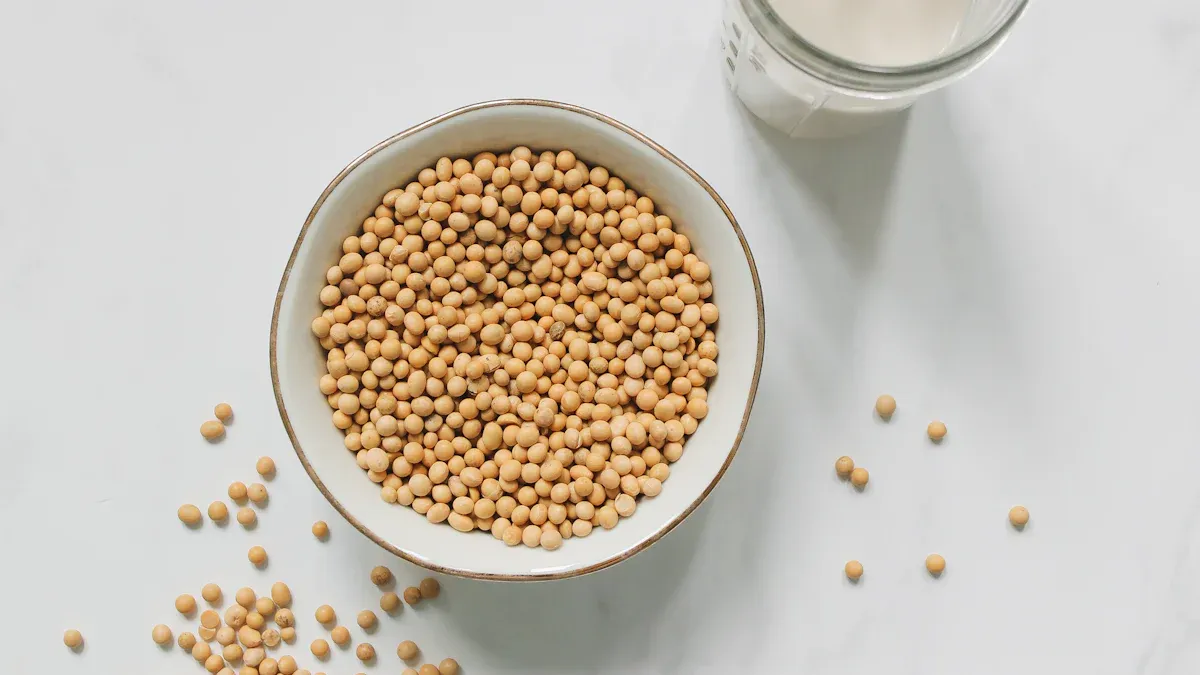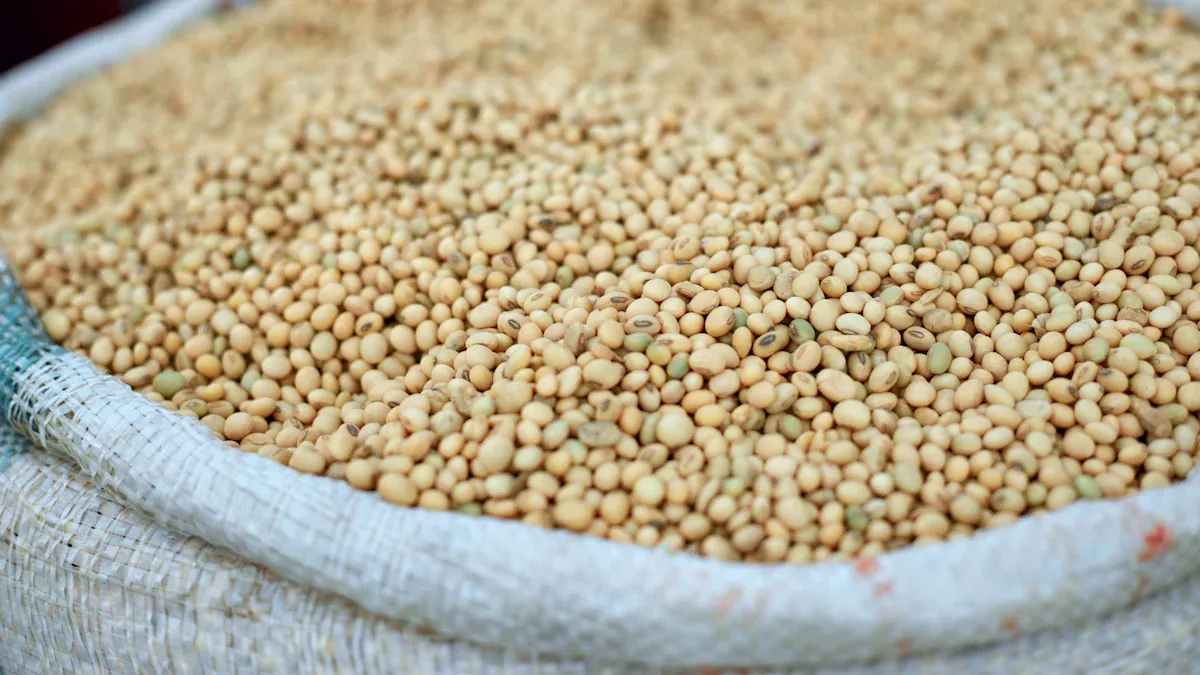You see more people picking plant-based proteins each year. The world market for soy protein isolate processing keeps growing. It is worth USD 4.29 billion in 2024 and may double by 2032.
More people want plant-based diets, so they buy more soy protein isolate.
Soy protein isolate is used in many foods, like meat and dairy substitutes.
New ways to enhance soy protein isolate processing help get more and better products. These include ultrasonic-thermal treatments and enzyme-assisted extraction. These new methods also improve taste and texture.
Technology | Benefit |
|---|---|
Ultrasonic-Thermal | Helps get more protein out |
Enzyme-Assisted | Makes protein quality scores higher |
Synergistic Treatment | Cuts bad flavors by over 70% |
Key Takeaways
Soy protein isolate has a lot of protein. It has about 85-90% protein. This makes it great for many foods.
New ways to get soy protein use ultrasound and enzymes. These ways help get more protein. They also make the protein taste and feel better.
New cleaning methods like membrane ultrafiltration use fewer bad chemicals. This makes soy protein safer and cleaner.
Things like pH and temperature change how soy protein works. They also change how well it mixes with water. So, people must watch these things closely.
New technology in soy protein processing helps the planet. It also saves energy and makes plant foods healthier.
Soy Protein Isolate Processing Overview

What Is Soy Protein Isolate
Soy protein isolate is made from soybeans. It has a lot of protein in it. Most of the time, it has 85-90% protein. This is much more than soybean flour or concentrate. Soy protein isolate has proteins like glycinin and β-conglycinin. These proteins help foods feel and taste better. They also make foods healthier.
Here is a table that shows how soy protein isolate is different from other soy protein products:
Characteristic | Soy Protein Isolate (SPI) | Soy Protein Concentrate | Soybean Flour |
|---|---|---|---|
Protein Concentration | 85-90% | ~70% | ~50% |
Major Proteins | Glycinin, β-conglycinin | Albumins, Globulins | Albumins, Globulins |
Solubility | High | Lower | Lower |
Water/Oil Binding | Varies by processing | Generally lower | Generally lower |
Soy protein isolate is used in many foods. It mixes well with water and oil. This helps make meat substitutes, dairy-free foods, and protein drinks.
Traditional Extraction Methods
There are steps to make soy protein isolate. The process starts with soybeans and ends with protein powder. Here is what happens:
First, soybeans are turned into flour or flakes. This is done by taking off the hull and grinding them.
Next, oil is taken out of the flour. A solvent called hexane is used for this.
Then, the protein is pulled out at a high pH, usually between 8.0 and 9.0.
After that, the protein is made to come out by lowering the pH to about 4.5. This is called the isoelectric point.
Last, the protein is made neutral and dried. This gives the final product.
Tip: If you watch the pH closely during acid precipitation, you get more protein and better purity.
Most factories use the alkaline extraction and acid precipitation method. This way, the soy protein isolate has over 90% protein. The product is pure and easy to use in lots of foods.
Challenges in Conventional Processing
Efficiency and Yield Issues
Traditional soy protein isolate processing has some problems. Many factories use wet extraction methods. These include alkaline or acid treatments. These methods can hurt the protein. They can make it harder to digest. Sometimes, the final product tastes bitter. Dry fractionation does not get all the protein out. Some protein stays in the starch. This means you do not get as much protein as you could.
Here is a table that lists the main problems with common extraction methods:
Extraction Method | Limitations |
|---|---|
Wet Extraction (Alkaline) | Lowers how well protein can be digested. It can break amino acids. It can make the taste bitter. |
Wet Extraction (Acid) | Makes it harder for protein to dissolve or form gels. |
Dry Fractionation | Leaves some protein in the starch. This lowers the total protein you get. |
General | Using bad solvents can pollute the environment. It uses a lot of energy. It can be bad for health. |
These methods often only remove about half the protein. This means you lose nutrients. It also wastes resources.
Quality and Environmental Concerns
Quality is another problem with old soy protein isolate processing. Strong chemicals can change the protein’s structure. This can make it less able to dissolve. It can also make it hard to form gels. These changes can affect how the protein works in foods.
There are also environmental problems. Farmers cut down forests to grow more soybeans. This happens in places like the Amazon. Growing only soybeans can hurt other plants and animals. Cutting down trees adds more carbon to the air. Factories use solvents like hexane. These can pollute the land and water. They can also leave bad stuff in the meal.
Cutting down forests for soybeans
Losing different kinds of plants and animals
More carbon in the air from clearing land
Using harmful chemicals in extraction
It is important to think about these problems when picking processing methods. Better technology can help get more protein. It can also make better quality and help the environment.
Advances in Soy Protein Isolate Processing

Innovative Extraction Techniques
There are new ways to get more protein from soybeans. These methods help you get more protein and better quality. Here are some of the most interesting techniques:
Ultrasonic-Assisted Extraction (UAE): This method uses sound waves to open up soybean cells. You can get more protein, up to 24.17%. The protein can be very pure, up to 91.6%. The protein pieces are smaller, so they mix better with water. Water and oil binding, emulsion, and foaming can be 40%-50% better than old ways.
Enzyme-Assisted Extraction (EAE): Enzymes break down cell walls. This makes it easier to get the protein out. This method gets 21% more protein than the old alkaline way. The protein is better and there is less waste.
Ultrasonic-Thermal Treatments: Using ultrasound with heat helps get even more protein. This method makes both yield and purity better.
Vacuum Degassing: This step takes out air bubbles during extraction. It helps make the protein cleaner.
Deep Eutectic Solvents with Microwave: These green solvents are safe for the earth. When used with microwaves, they make extraction faster and save energy. They also keep the protein’s natural features safe.
Here is a table that shows how these methods compare:
Extraction Method | Protein Recovery Rate (%) | Notes |
|---|---|---|
Traditional Alkaline Extraction | 35.43 | Lower yield, more waste |
Ultrasonic-Assisted Extraction (UAE) | 76.83 | Higher yield, better solubility |
Enzyme-Assisted Extraction (EAE) | 21% increase over alkaline | Improved quality, less damage to protein |
Tip: If you want protein that mixes better and works well, try using ultrasound or enzymes when making soy protein isolate.
Modern Purification Methods
After getting the protein, you need to clean it. New methods help you get a safer and cleaner product. You can use these ways:
Membrane Ultrafiltration: This method uses special filters to sort protein by size. You get very pure soy protein isolate without strong chemicals.
Reverse Micellar Extraction: This process uses tiny drops called micelles to pull out protein. It gives very pure protein, but it is hard to use for big batches.
Membrane Separation: This is another way to filter out things you do not want. The product tastes better and has fewer bad parts.
Modern cleaning methods often use natural chemicals, not strong ones like hexane or alcohol. This makes the protein safer for you and better for the earth. You also do not get leftover chemicals in your food. More people want natural and healthy foods, so these new ways are getting more popular.
Impact of Processing Conditions
How you process soy protein isolate changes its quality. You need to watch things like temperature, pH, and pressure. Each one changes how the protein works in food.
pH: The best mixing happens at pH 6. This means the protein mixes well with water and works better in drinks and sauces.
Temperature: Heat can change how protein acts. At 25°C to 75°C, mixing stays the same, but higher heat can change how the protein thickens or gels.
Pressure: High pressure can make the protein open up or stick together. This can help it mix better and make stable emulsions.
Here is a table that shows how these things affect the protein:
Processing Condition | Effect on Solubility | Effect on Functional Properties |
|---|---|---|
pH | Best at pH 6 | Better at mixing and making emulsions |
High Pressure | Can make protein open or clump | Helps make stable emulsions at neutral pH |
Temperature | Stays the same at 25–75°C | Changes how protein thickens or gels |
You can also use enzymes to make the protein better. Enzymes can add more amino acids and antioxidants. They also make the protein easier to digest and less likely to cause allergies.
Note: If you want to make soy protein isolate processing better for the earth, try deep eutectic solvents and microwave-assisted extraction. These ways use less energy and make less waste.
By using these new methods and watching how you process, you can get soy protein isolate that mixes better, gives more yield, and works better in foods. This helps you make better foods and meet the need for plant-based protein.
Applications and Comparative Analysis
Industry Applications
Soy protein isolate is used in many industries. Food makers put it in meat, drinks, and bread. Nutrition companies add it to health supplements. Farmers mix it into animal feed for animals. Medicine makers use it in some drugs.
Here is a table that shows where soy protein isolate is used:
Industry Application | Examples |
|---|---|
Food and Beverages | Meat products, cold drinks, baked goods |
Nutritional Supplements | Health-focused products |
Animal Feed | Feed for livestock |
Pharmaceuticals | Medicinal products |
Soy protein isolate is also found in baby formula. Studies say advanced soy protein isolate helps babies grow well. One study found babies who had soy formula got more essential amino acids. Another study showed no big difference in growth between regular and lower protein soy formulas.
Study Name | Population | Formula Types | Key Findings |
|---|---|---|---|
Giovannini Study | Human milk, SIF, whey-based hydrolyzate, casein-based hydrolyzate, soy plus collagen-based hydrolyzate | Higher essential amino acids in soy formula | |
Churella Study | 84 infants | Normal soy protein, lower soy protein | No difference in growth; lower plasma urea nitrogen |
Tip: You can add soy protein isolate to many foods and health products. It helps make nutrition and texture better.
Comparative Performance
You may wonder how new soy protein isolate methods compare to old ones. New ways use pH changes and washing with water. These steps help get more protein and make it cleaner. Wet fractionation gives very pure protein, but can change how it works. Dry fractionation keeps more natural parts of the protein.
New methods have these good points:
Washing with water takes out things you do not want. This makes the protein taste better and easier to digest.
Isoelectric precipitation and ultrafiltration keep protein strong. Ultrafiltration works better than old ways.
Alkaline extraction for baru protein concentrate gives high protein, like soy. This means new methods work well.
New methods may cost more at first. They use less energy and make less waste. Over time, you save money and help the earth.
Note: New soy protein isolate processing methods give higher yield, better purity, and help the environment more than old techniques.
Future Trends
Emerging Technologies
Many new technologies are changing how soy protein isolate is made. These methods help save energy and make better protein. Some promising technologies are:
Membrane ultrafiltration uses special filters to separate proteins. This method gives higher purity and uses less energy.
High-pressure processing makes proteins easier to digest. It also lowers the chance of allergies.
Ultrasound and microwave treatments help get more protein from soybeans. They also lower unwanted parts.
Enzyme-assisted extraction uses natural helpers to break down soybeans. This improves how much protein you get.
These new methods make work faster and cleaner. They also help the planet by using less water and fewer chemicals. When you use these technologies, you get better soy protein isolate for food and drinks.
Note: New production methods can make things more efficient. They can lower costs and help make products more sustainable.
Research Directions
Research in soy protein isolate processing is moving quickly. Many scientists want plant-based foods to taste and feel better. Here are some main research areas:
Optimizing extrusion helps make plant-based foods with better texture.
New ways to shape proteins include shear cells, 3D printing, and electrospinning.
Improving equipment makes processing faster and safer.
Scientists study how flavors stick to soy protein. This is not well understood yet.
Finding the best heat settings for soymilk is important. There are no clear rules now.
Researchers also look for ways to meet food safety rules. They want to keep products safe for you. They make sure new methods do not leave harmful residues. More people want clean-label and eco-friendly products. So, there is more focus on healthy and sustainable foods.
Tip: To keep up with new trends, watch for studies on ingredient innovation and equipment upgrades.
You can see big changes in how soy protein isolate is made. New ways to get the protein make it taste better. The texture is smoother and the protein is higher quality. Soy protein isolate is now in more foods. You find it in dairy alternatives and protein bars. New ideas help lower anti-nutrients and cut food waste. These changes make plant-based proteins healthier. They also help them be better for the planet. Soy protein isolate will matter more as people pick eco-friendly foods.
FAQ
What is soy protein isolate used for?
Soy protein isolate is in many foods. It is in meat substitutes, protein drinks, and baked goods. Companies add it to make foods healthier. It also helps foods feel and taste better. You can find it in baby formula and health supplements.
How do new extraction methods help you?
New ways like ultrasound and enzymes get more protein from soybeans. These methods give higher purity and better taste. They use less energy and make less waste. This helps the environment and gives you better food.
Tip: Choose foods made with new extraction methods for better nutrition.
Is soy protein isolate safe for you?
Soy protein isolate is safe to eat. Scientists check it for quality and purity. Most products follow strict food safety rules. If you are allergic to soy, you should not eat it.
What makes modern purification better?
Method | Benefit |
|---|---|
Membrane Filtration | Takes out impurities |
Reverse Micelles | Makes protein very pure |
Water Washing | Makes food taste better |
Modern purification gives you cleaner protein. It uses fewer chemicals. This means your food is safer and tastes better.

